Equipment of checkpoints. School security - ensuring student safety
23. Inspection and passage of people, vehicles and cargo are carried out at checkpoints. By purpose they can be:
– checkpoint for passing people;
– checkpoint for entry road transport;
– Checkpoint for the passage of railway transport.
24. The number of checkpoints at a guarded facility of the penal system is determined depending on the length of the perimeter of the facility, its configuration, the intensity of traffic of people and vehicles through the checkpoint.
25. At the checkpoint for the passage of people and vehicles, a building with a height of no more than three floors is being built with a gateway and the premises of the PUTSO sentry operator located at the level of the top floor, or a one-story building without a gateway and the premises of the PUTSO sentry operator.
The choice of a checkpoint building depends on the nature of the security facility, the occupancy and the regime of detention of convicts in the penal institution. The checkpoint building is located so that its back side coincides with the security line (main fence).
The two-story checkpoint building provides for: a passage corridor, a room for accommodating a guard, a room for a PUTSO sentry operator, a gateway, and a room for a checkpoint sentry.
The one-story building contains: a passage corridor; guardhouse.
At the permanent checkpoint production facility A one-story building with a room for a PUTSO watch operator at the level of the ground floor covering is being built at a correctional system located remote from the institution, and a control platform is being equipped.
26. Facilities and structures at the checkpoint include:
– structures in the passage corridor;
– control platform;
– anti-ramming devices;
– inspection pits;
– overpasses for vehicle inspection.
Options for structures and structures at the checkpoint are given in Appendix 5.
27. Control equipment checkpoints for letting people through
1) To ensure access control A passage corridor is equipped at the checkpoint.
2) A cut-off vestibule is installed in the passage corridor, which is formed by the walls of the corridor and two lattice partitions made of vertical round steel rods with a diameter of at least 16 mm and transverse strips with a size of at least 60x5 mm. The clean cell dimensions are no more than 100x200 mm. Doors installed in lattice partitions are made similar in material and parameters to these lattice partitions.
3) Doors passage corridor(except for the doors of the cut-off vestibule) are made of reinforced construction. In the doors for passage to the airlock and entrance to the control platform, observation windows measuring 60x60 mm, locked from the side of the airlock (control platform), located at a height of 1.5 m from the floor, are installed.
4) The window in the passage corridor from the side of the sentry checkpoint is installed along the entire length of the cut-off vestibule and is equipped with a metal grill. To prevent an attack on a checkpoint sentry and to protect him from small arms fire, the window can be equipped with armored glass. Metal grate in this case it is not installed.
The window sill is located at a height of no more than 0.3 m from the floor. A window and (or) a retractable tray is installed in the window in front of the sentry checkpoint for receiving (issuing) documents and weapons from passing persons.
5) To provide the sentry checkpoint with an overview of the “dead zones” of the passage corridor, video surveillance equipment or mirrors are installed opposite the window, at the corners of the cut-off vestibule.
6) To suppress attempts to deliver weapons and other prohibited items to convicts and persons in custody, control and inspection devices are installed in the passage corridor.
7) All external entrance doors the passage corridor is equipped with intercoms with a calling button, viewing eyes with a rotating lid and electromechanical locking devices controlled from the sentry checkpoint room. It is allowed to install video surveillance devices instead of viewing eyes.
8) The doors of the passage corridor are equipped with electromechanical locking devices controlled from the checkpoint sentry room. The locks are controlled by the door locking mode, in which it is impossible to open one door if the second one is open. When an alarm signal is issued, the opening of all doors in the checkpoint passage corridor is blocked. Unlocking is carried out by the head of the guard.
28. Equipment of checkpoints for the passage of road and rail transport
1) At the checkpoint for the passage of vehicles, the following are arranged:
- control platform.
In pre-trial detention centers (prisons) only a gateway can be installed.
2) The gateway is equipped with:
– main (external) and auxiliary (internal) gates;
– anti-ramming devices;
– inspection pit;
– an overpass for vehicle inspection;
- lighting fixtures.
Options for gearbox equipment are shown in Figures 3.1 – 3.4.
3) The main gates are made as sliding single-leaf or double-leaf with electromechanical and manual emergency drive. The gate design is framed, metal, with continuous filling and no through gaps. In the gate at a height of 1.6 m it is allowed to install a closing viewing window measuring 150x150 mm. The gates are equipped with locking and locking (electric locking) devices.
Auxiliary gates are made as sliding or swing gates. The gate design is framed, metal, with continuous filling.
There are no wickets installed at the main and auxiliary gates.
An anti-ram stop is installed in the lock in front of the main gate.
4) On the outside of the main and auxiliary gates, at a distance of at least 3.0 m from them, a transverse line with the inscription “Stop” is drawn on the access platform, and a corresponding traffic sign is installed.
5) To prevent ramming of the lock gates by vehicles, straight sections of external and internal roads with a length of more than 50 m are not constructed before entering the lock. For the same purpose, it is possible to install an inspection pit in the gateway with an offset relative to the gate axis by 0.4 - 0.6 m.
6) Main and auxiliary gates, anti-ram stops and rigid barriers are equipped with automation and mechanization equipment.
Gate drives and anti-ramming devices, as well as electric locking devices, are equipped with remote control and automatic locking. Push-button posts remote control located in the inspection team room and in close proximity to the gate. The drive design provides for the possibility of switching to manual control in the event of a power outage. The gate drive control circuit is designed to ensure sequential opening (closing) of the main and auxiliary gates.
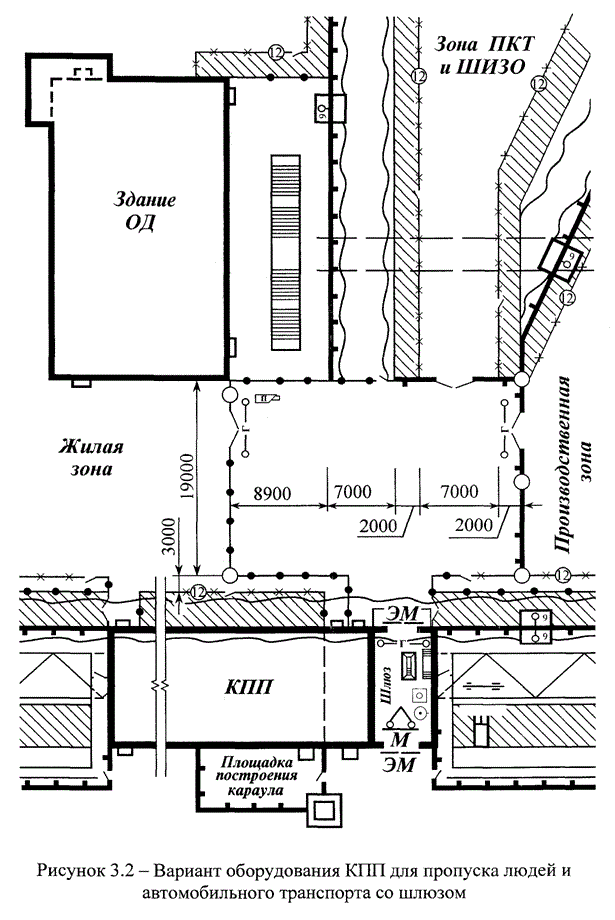
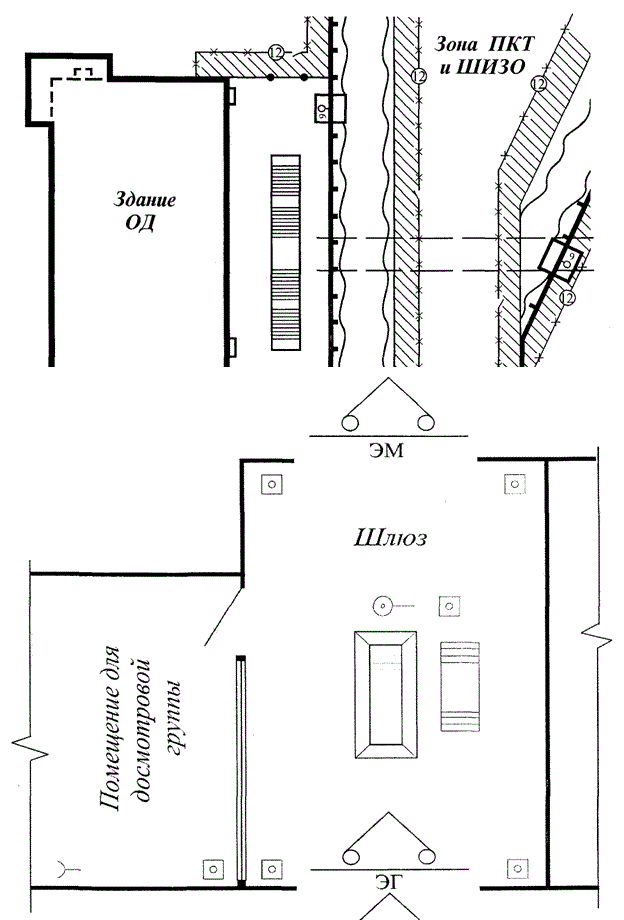
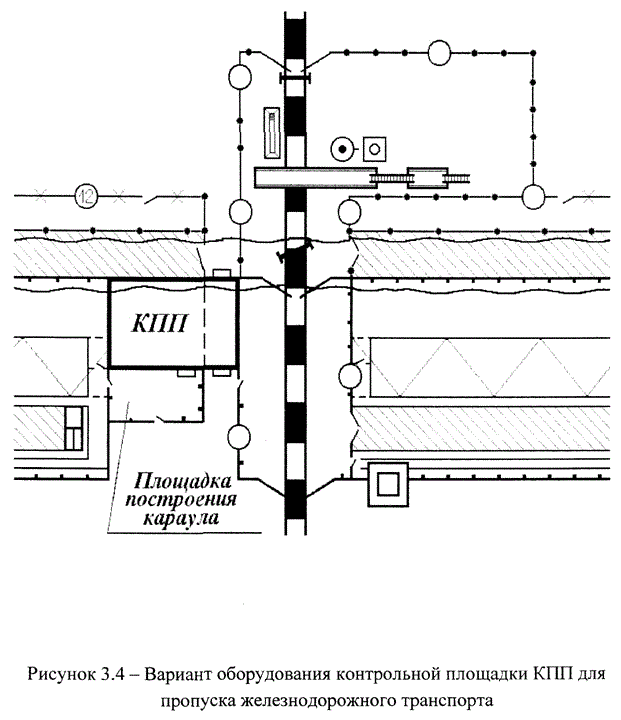
Locking of gates, anti-ramming and electric locking devices is carried out automatically when an alarm signal is given. Unlocking is carried out by the head of the guard.
The inspection team's room provides an overview of the entire gateway area.
7) Lamps for illuminating the gateway are installed on the walls or under the roof no lower than the level of the upper edge of the gate. The luminaires are equipped with mechanical protection.
8) Inspection of vehicles is carried out at a control site located inside the security facility. The dimensions of the control area are selected based on the dimensions of the inspected transport (for railway transport - the simultaneous location of at least three freight railway cars on it). The control platform is made with a hard surface. The fencing of the control area is arranged in accordance with paragraphs. 18 clause 17 of this Manual. A version of the control platform equipment is shown in Figure 3.5.
9) In the fencing of the control area, wickets (gates) are installed for passage (passage) into the restricted area of the facility and into visible corridors, which are equipped with locking (gates - self-locking locking) devices and are blocked by a security alarm.
At the control site for road transport, an overpass for vehicle inspection, an inspection pit and anti-ram barriers (anti-ram stop and flexible barrier), as well as a post for a service dog used during inspection are equipped Vehicle. The anti-ram stop is installed at the exit from the control area in front of the main gate. Instead of an anti-ram stop, a rigid barrier can be installed one meter from the main gate. Flexible barriers are attached to the posts of the main (if the gate is swinging) and auxiliary gates, intended for passage into residential and industrial areas. The main gates, rigid barriers and anti-ram stops are equipped with automation and mechanization equipment. The design of the main gate provides for the possibility of emergency blocking when the inspection team sends an alarm signal in the event of an emergency. emergency at the control site. For inspection of railway transport, an overpass, side inspection pits and portable anti-ramming devices are equipped.
If necessary, a secure leash post for a service dog is set up at the control area near the main gate.
Security lighting fixtures are installed on free-standing supports along the fence line of the control area or on brackets along the top of the fence.
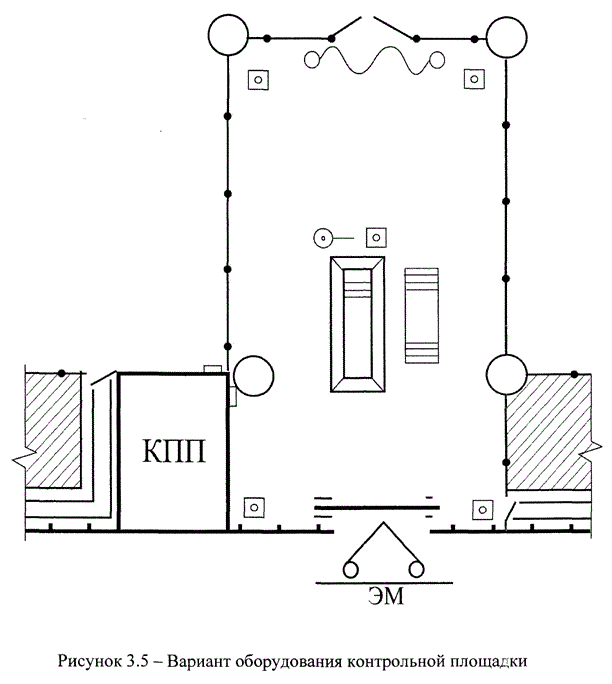
At the control site (in the gateway), sockets with a voltage of no more than 42 V are installed to turn on portable lamps and detection devices used during vehicle inspection; means of operational communication; ringing devices alarm system; places are equipped for storing equipment used during vehicle inspections.
10) Calling devices for alarm systems are installed in the room for the inspection team, on the overpass for vehicle inspection and in the inspection pit, as well as on the rest of the control area (gateway), so that in the event of an emergency a signal can be given from any place anxiety.
11) The control platform (gateway) is equipped with video surveillance equipment.
Development electronic systems security is increasingly included in daily life. Interest in this equipment is constantly growing, and not so long ago, companies developing such technologies began to introduce access control to schools.
What tasks do control systems perform in educational institutions?
School is the place where children spend most of their day, and therefore the educational institution must meet the highest safety requirements.
The main task security systems in schools is to control and restrict access to the territory. When sending a child to school, parents, first of all, want it to be safe.
The photo shows a turnstile at a school
In addition to the fact that the school will be protected from intrusion by strangers, the access control system has a number of useful additional functions:
- SMS notifications to parents. This function can only be enabled with the consent of the student’s parents. The need to use it is related to promptly notifying parents about the time the child is at school;
- Delay control. The importance of introducing this function is justified by the fight against tardiness and absence training sessions. Thus, the system stores information about each student in memory and, if necessary, you can easily create an attendance report not only for an individual student, but also for the class as a whole. With the introduction of such control, it is safe to say that the school is developing a sense of discipline and punctuality;
- Electronic diary. Gives parents the opportunity, without leaving their work, using a computer and the appropriate password to access the site and view their child’s grades;
- Automation of payments for children's meals at school. The access control system allows, using an identifier, for example, a plastic card on which certain cash, pay for purchased food in the canteen. The student will only need to present the card, and the cost of his lunch will be debited from it. This function is also useful because the child will not have money on hand that he can spend on something unnecessary. In addition, purchasing food for the school canteen will be much easier, since the money in the student’s account will actually be an advance payment that can be used.
You can see more details about all these functions in this video:
System components and operating principle
The main components of an access control system are an identifier, a reader and a controller.
An identifier is an electronic device that is used to determine the authority and rights of a person to enter a protected area. Such keys can be:
- Contactless cards (Proximity), which can work at a distance of approximately 1-2 centimeters;
- Magnetic cards;
- Key fobs.
The reader pumps information from the identifier and then transfers it to the ACS controller. This device is installed at the entrance to the school building. The principle of operation is this: when the identifier comes within the range of the reader, the latter transmits a signal to the controller, which makes a decision about whether passage is possible or whether it is prohibited.
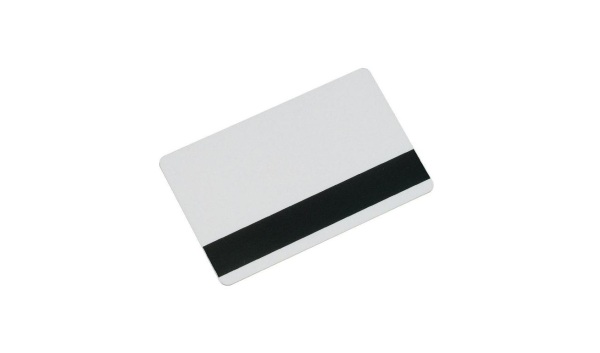 In the photo you see an image of a magnetic card for the access system
In the photo you see an image of a magnetic card for the access system All information is sent to the controller. He makes decisions and is responsible for correct work execution devices. This device monitors and manages the entire system, therefore it stores in its memory various identifier codes and their rights to enter, as well as time of arrival, etc.
The operating principle of ACS at school is quite simple and any child can easily use it:
- At the entrance to the school premises, a special turnstile for passage with a built-in access control system is installed;
- Previously, the school enters information into the system and issues plastic cards(identifiers) for each student, teacher and staff member, that is, they receive pass cards;
- When approaching the turnstile, you need to present your ID to a special place. At the same time, the access control system at the school reads the information from the card, identifying the person who came, and if the card is registered, it will open the turnstile for passage. Otherwise, passage through the turnstile will be closed. In addition, the system will automatically save information about incoming messages, for example, time of entry or exit, which can be viewed at any time using a computer. Next, an SMS will be sent to parents informing them that their child has arrived at school indicating the time.
Detailed information about the system at school and the principle of its operation is shown in this video:
What must be taken into account when organizing access to the territory?
Any school must have several entrances and exits, since installing access control at just one central entrance does not prevent an unauthorized person from entering the educational institution. The correct organization of the passage and placement of actuators (turnstiles or electronic locks) where the access control system is used is very important. If IDs were issued not only to all students, teachers and service personnel, but also to parents of students, situations may still arise when a school security guard may allow entry to the school without a special pass card or by issuing a temporary pass.
You will see interesting information about poverty in schools in this video:
The first reason for allowing entry into an educational institution is students who have forgotten their ID or lost it. The second reason may be persons who do not have an identifier due to the fact that they are not school employees, but periodically come to the educational institution. This could be, for example, a grocery loader driver who brought food to the school canteen, or a foreman starting the heating system, etc. The third reason could be the student’s relatives, whom the parents asked to pick up the child from school. The school will be sufficiently secure if access for this category of people is properly organized.
 The photo shows schoolchildren near access system
The photo shows schoolchildren near access system The system allows you to control access to the school premises without identification in automatic mode. In other words, a case of passage through the access control system in the so-called manual mode will be recorded in her memory, therefore, you can find out from the school security guard who he allowed to enter the territory and for what reason. If, nevertheless, an intruder somehow entered the school, then the video surveillance cameras integrated into the access control system will record him. At the same time, it is important that the administration educational institution took a responsible approach to security briefings, since this was strictly human factor minimizes the effectiveness of all protective systems.
To organize access control, the enterprise is equipped with checkpoints. The checkpoint equipment must provide the necessary throughput and the ability to thoroughly check passes and documents of passing persons, inspect all types of transport, transported cargo and meet the following requirements:
exclude the possibility of unauthorized entry of people and vehicles through the checkpoint into the facility (from the facility);
- help reduce the time for checking documents, inspecting vehicles and material assets;
- provide security measures for security guards during vehicle inspections.
Checkpoint for the passage of people
To control people entering the facility and individual buildings (premises), checkpoints are built. It is recommended to equip each checkpoint with a security room, a room for screening citizens, a storage room, a wardrobe, and a turnstile with locking devices.
The placement of premises is determined by the projects and depends on the means of mechanization, gearbox automation and the characteristics of the enterprise.
Passages are arranged in the control room, which are equipped with technical security means and physical barriers. The equipment set usually includes:
- means of mechanization, automation of access control systems;
- main and backup lighting;
- communications and alarm systems;
- video monitoring systems.
When choosing a turnstile, you need to keep in mind that they come in “normally open” and “normally closed.” “Normally open” turnstiles (for example, sliding ones, which until recently were installed in the Russian metro) are used quite rarely in world practice. They can hit a passer and do not allow effective control.
To implement reliable control, “normally closed” turnstiles are more often used: rotary turnstiles, tripod turnstiles and gates.
Gates are used to control the flow of people, organize free passage in one direction (to the entrance or exit) and prohibit passage in the other. Gates are widely used in shops, airports, and train stations. The use of gates for access control is ineffective, this is due to the fact that the gates do not separate the flow of people one by one, since after opening the gate several people can pass through it. Gates can be installed to organize a free exit, while entry control is entrusted to tripods or turntables.
Tripod turnstiles with three barrier bars are one of the most optimal means to control authorized passage. The tripods have a modern, elegant look and are easy to install. Tripods allow for effective access control, as they separate the flow of people one at a time, while providing high throughput. Tripods can be used in electronic checkpoint systems, including in conditions of a large flow of people. To prevent the possibility of crawling under the turnstile bars or jumping over them, it is recommended to install special sensors on the turnstile that are triggered when an unauthorized person attempts to pass.
Rotary turnstiles are used in cases where complete blocking of the passage area is necessary. They can vary in height - from waist turnstiles to full-height turnstiles, which are structurally similar to revolving doors.
Transport checkpoints
The transport checkpoint includes an inspection platform and office premises. The inspection area is designed to accommodate vehicles during inspection. Inspection sites can be located both on the territory of the enterprise and outside it, in the area directly adjacent to the main gate of the checkpoint. The inspection platform must meet the following requirements:
- have sufficient area to accommodate inspected vehicles, technical means to ensure normal working conditions for the security guard;
- exclude the possibility of unauthorized entry into the facility (from the facility) of people and vehicles;
- be isolated from other structures that are not related to the security of the facility and the checkpoint equipment;
- provide security measures for security guards while performing their duties.
transported goods and can be: 10-12 meters in length and 5-6 meters in width.
On the territory allocated for the construction of the inspection platform, the terrain is graded in such a way that rain and melt water do not linger on it. The transverse slope of the inspection area is made at least 2% from the place where the guard is posted in the direction of its sides (perpendicular to the roadway). The surface of the inspection area is covered with concrete or asphalt.
On the roadway of the site there is a designated stopping place for vehicles for inspection, limited by two “STOP” lines painted in white.
Before entering the inspection area, on the outside of the main and auxiliary gates (barriers), no closer than 3 meters from them, a transverse line and the inscription “STOP” are also applied. In order to ensure traffic safety, at least 100 meters from the gate with right side or a sign “Move in one direction” is installed above the road
row", and 50 meters from the gate there is a speed limit sign of up to 5 km/h.
Transport checkpoints can be equipped with traffic lights, scales for weighing vehicles, an inspection pit or overpass for inspecting cargo, and mechanized devices for automatic opening and closing gates with locks.
Inspection areas along the perimeter are equipped with physical barriers and an alarm line. Sites, as a rule, are fenced off with a visible fence made of metal mesh or decorative grilles up to 2.5 meters high. The site is equipped with main and auxiliary mechanized gates. The main gate is installed on the line of the main fence of the facility, and the auxiliary gates are installed on the opposite side of the inspection area. Instead of gates, mechanized barriers can be used. At automobile checkpoints, gates with and without height restrictions are used. By design, they can be hinged or sliding (retractable). Swing gates must be equipped with latches.
To regulate the movement of vehicles passing through the passages of checkpoint inspection areas, two-section traffic lights with red and green lenses can be used.
The electromechanical equipment of gearboxes for road transport usually includes:
- electric motors, gate drive;
- limit switches for automatic shutdown of electric motors when the gate leaves are completely closed and open;
- magnetic motor starters;
- electrical equipment of traffic lights;
- cable, power lines.
1. General provisions. This section states:
Regulations, on the basis of which the instructions were drawn up;
Definition of the access control regime and the purpose of its establishment;
Who is responsible for the management of access control and its practical implementation;
Sanctions for violators of the access control regime;
Requirements for equipment of various premises.
2. The procedure for passing enterprise employees, business travelers and visitors through checkpoints. This section recommends:
List all checkpoints and their purpose, description, location and establish their uniform numbering;
State the requirements for gearbox equipment;
Establish the procedure for the passage of employees and visitors to the territory of the facility and to categorized units;
Determine the rights and main responsibilities of checkpoint controllers;
Establish premises where it is prohibited to receive visitors and representatives of third-party organizations.
3. The procedure for admitting vehicles to the facility, exporting products, documents and material assets. This section states:
The procedure for admitting vehicles belonging to the facility to the territory of the facility (from the facility);
Entry and parking on the territory of the facility of vehicles owned by employees as personal property;
The procedure for passing vehicles of third-party organizations that arrived with cargo at the facility during working and non-working hours;
The procedure for the export (import) of inventory items;
Rules for processing documents for the removal (removal) of material assets from the territory of the facility.
4. Types of passes, the procedure for issuing them. This section defines:
Types of passes, their number and status;
Description of passes;
The procedure for registration and issuance of passes;
General replacement and re-registration of passes;
Actions to take if an employee loses a pass.
5. Responsibilities officials to maintain the access control regime.
6. Accounting and reporting, the procedure for storing passes and seals.
Depending on the structure of the enterprise and the nature of its activities, the instructions may contain other sections.
Types of passes:
To gain access to an enterprise or individual premises, as a rule, several types of passes are installed. These can be: permanent, temporary, one-time and material passes. Samples of pass forms are developed by the facility administration (security service). In my own way appearance and the contents of the pass must differ from each other and have protective properties. All types of passes, with the exception of material ones, are processed and issued by the pass office (or other department) upon written requests. Types of passes are determined depending on the specifics of the enterprise.
Permanent passes are issued to facility employees hired for permanent job, as well as employees of other organizations assigned to the constant maintenance of the facility. Permanent passes can be divided into groups, their number and purpose are determined by the instructions on the access control regime. Permanent passes can be kept both in the hands of facility employees and in booths at checkpoints. Permanent passes of persons leaving the facility for a long time (vacation, illness, business trip, etc.) are deposited in the pass office (HR department), and when such passes are left in the cabin, in the cell (where the pass is stored) corresponding mark. The passes of those dismissed from work are destroyed in accordance with the established procedure.
Temporary passes are issued to persons working under a contract, in temporary work, seconded to an enterprise and are stored, as a rule, at the checkpoint. The validity period and procedure for issuing temporary passes is determined by the instructions on the access control regime.
Temporary passes can be with or without a photo. Temporary passes without a photograph are valid only upon presentation of an identification document.
One-time passes (for visitors and clients) are issued to one person and only for a one-time visit to the enterprise and its divisions. The pass is issued and valid upon presentation of an identification document. One-time passes should be periodically changed according to the color of the forms and other distinctive features.
A one-time pass issued to the driver of a vehicle can also serve as a one-time pass for transport.
A one-time pass is valid for entering the territory of an object or its subdivision for a certain time.
Control over those visiting the enterprise with a one-time pass is carried out using a mark on the back of the pass, which indicates the time of the visit, certified by the signature of the person who received the visitor.
A one-time pass is confiscated at the checkpoint by the controller when the visitor leaves the site and is handed over to the pass office. The controller reports to the head of the guard (checkpoint duty officer) about persons who did not leave the facility after the expiration of the established period of validity of the pass to take measures to determine the reasons for the delay. The names of persons who visited the facility with a one-time pass can be recorded in a special accounting book.
Material passes for the export (removal) of inventory items are issued by the administration of the enterprise. The validity period of the pass is determined by the instructions on the access control regime. Material passes must be confiscated at the checkpoint and handed over to the pass office.
Samples of valid passes must be available at the checkpoint. Funds are allocated for training security workers required amount samples
Gearbox equipment
To organize access control, the enterprise is equipped with checkpoints. The checkpoint equipment must provide the necessary throughput and the ability to thoroughly check passes and documents of passing persons, inspect all types of transport, transported cargo and meet the following requirements:
Eliminate the possibility of unauthorized entry of people and vehicles through the checkpoint into the facility (from the facility);
Contribute to reducing the time for checking documents, inspecting vehicles and material assets;
Help eliminate (minimize) security guard errors when allowing people and vehicles through;
Provide security measures for security guards during vehicle inspections;
All types of checkpoints must be equipped with the necessary types of communication and alarm systems to call the security reserve. It is recommended to have an internal telephone number and a list of telephone numbers for the enterprise administration at the checkpoint.
Checkpoint for the passage of people.
To control persons entering the facility and individual buildings (premises), checkpoints are built. It is recommended to equip each human checkpoint with: a security room, a room for screening citizens, a storage room, a wardrobe, a turnstile with locking devices.
The placement of premises is determined by the projects and depends on the means of mechanization, gearbox automation and the characteristics of the enterprise.
Passages are arranged in the control room, which are equipped with technical security means and physical barriers. The equipment set usually includes:
Means of mechanization, automation, access control systems;
Physical barriers (fences, turnstiles, gates;
Main and backup lighting;
Communication and alarm systems;
Video monitoring systems.
Various turnstiles can be used as access control devices. Turnstiles are designed to control the flow of people and regulate entry (exit). Recently, electromechanical turnstiles have become most widespread. Electromechanical turnstiles, unlike mechanical ones that are cumbersome and inconvenient to operate, are easily controlled from the security guard’s console and can work as part of an automated access control system.
When choosing a turnstile, you need to keep in mind that they come in “normally open” and “normally closed” types. “Normally open” turnstiles (for example, sliding ones, which until recently were installed in the Russian metro) are used quite rarely in world practice. They can hit a passerby and do not allow effective control.
To implement reliable control, “normally closed” turnstiles are more often used: rotary “turntable” turnstiles, tripod turnstiles and gates.
Gates are used to control the flow of people - organization - organizing free passage in one direction (to the entrance or exit) and prohibiting passage in the other. Gates are widely used in shops, airports, and train stations. The use of gates for access control is ineffective, this is due to the fact that the gates do not separate the flow of people one by one, since after opening the gate several people can pass through it. Gates can be installed to organize a free exit, while entry control is entrusted to tripods or “turntables”.
Tripod turnstiles with three barrier bars are one of the most optimal means for monitoring authorized passage. The tripods have a modern, elegant look and are easy to install. Tripods allow for effective access control, as they separate the flow of people one at a time, while providing high throughput. Tripods can be used in electronic checkpoint systems, including in conditions of a large flow of people. To prevent the possibility of crawling under the turnstile bars or jumping over them, it is recommended to install special sensors on the turnstile that are triggered when an unauthorized entry is attempted.
Rotary turnstiles are used in cases where it is necessary to completely cover the passage area. They can vary in height - from waist turnstiles to full-height turnstiles, which are structurally similar to revolving doors.
Motor transport checkpoints.
The motor vehicle checkpoint includes an inspection platform and office premises. The inspection area is intended to accommodate vehicles during inspection. Inspection sites can be located both on the territory of the enterprise and outside it, in the area directly adjacent to the main gate of the checkpoint. The inspection platform must meet the following requirements:
Have sufficient area to accommodate inspected vehicles, technical means to ensure normal working conditions for the security guard;
Eliminate the possibility of unauthorized entry into (from the facility) people and vehicles;
Provide inspection of motor vehicles and transported goods at the established traffic intensity, at any time of the day or year;
Be isolated from other structures that are not related to the security of the facility and the checkpoint equipment;
Ensure security measures for security guards while performing their duties.
The dimensions of the inspection area are set depending on the dimensions of the transport and the goods being transported and can be: 10-12 meters in length and 5-6 meters in width.
On the territory allocated for the construction of the inspection platform, the terrain is graded in such a way that rain and melt water do not linger on it. The transverse slope of the inspection area is made at least 2% from the place where the guard is posted in the direction of its sides (perpendicular to the roadway). The surface of the inspection area is covered with concrete or asphalt.
On the roadway of the site there is a designated stopping place for vehicles for inspection, limited by two “STOP” lines painted in white.
Before entering the inspection area, on the outside of the main and auxiliary gates (barriers), no closer than 3 meters from them, a transverse line and the inscription “STOP” are also applied. In order to ensure traffic safety, a “Single Lane Driving” sign is installed at least 100 meters from the gate on the right side or above the road, and a speed limit sign of up to 5 km/h is installed 50 meters from the sign.
Motor transport checkpoints can be equipped with traffic lights, scales for weighing cars, an inspection pit or overpass for inspecting cargo, and mechanized devices for automatically opening and closing gates with locks.
Inspection areas along the perimeter are equipped with physical barriers and an alarm line. Sites, as a rule, are fenced off with a visible fence made of metal mesh or decorative gratings up to 2.5 meters high. The site is equipped with main and auxiliary mechanized gates. The main gate is installed on the line of the main fence of the facility, and the auxiliary gates are installed on the opposite side of the inspection area. Instead of gates, mechanized barriers can be used. At automobile checkpoints, gates with and without height restrictions are used. By design, they can be hinged or sliding (retractable). Swing gates must be equipped with latches.
To regulate the movement of vehicles passing through the passages of checkpoint inspection areas, two-section traffic lights with red and green lenses can be used.
The electromechanical equipment of gearboxes for road transport usually includes:
Electric motors, gate drive;
Limit switches, automatic shutdown of electric motors when the gate leaves are completely closed and open;
Magnetic motor starters;
Electrical equipment of traffic lights;
Cable, power lines.
A group distribution board (control panel) can be installed in the checkpoint room, and in the absence of a checkpoint building, in a special metal cabinet directly at the inspection site.
